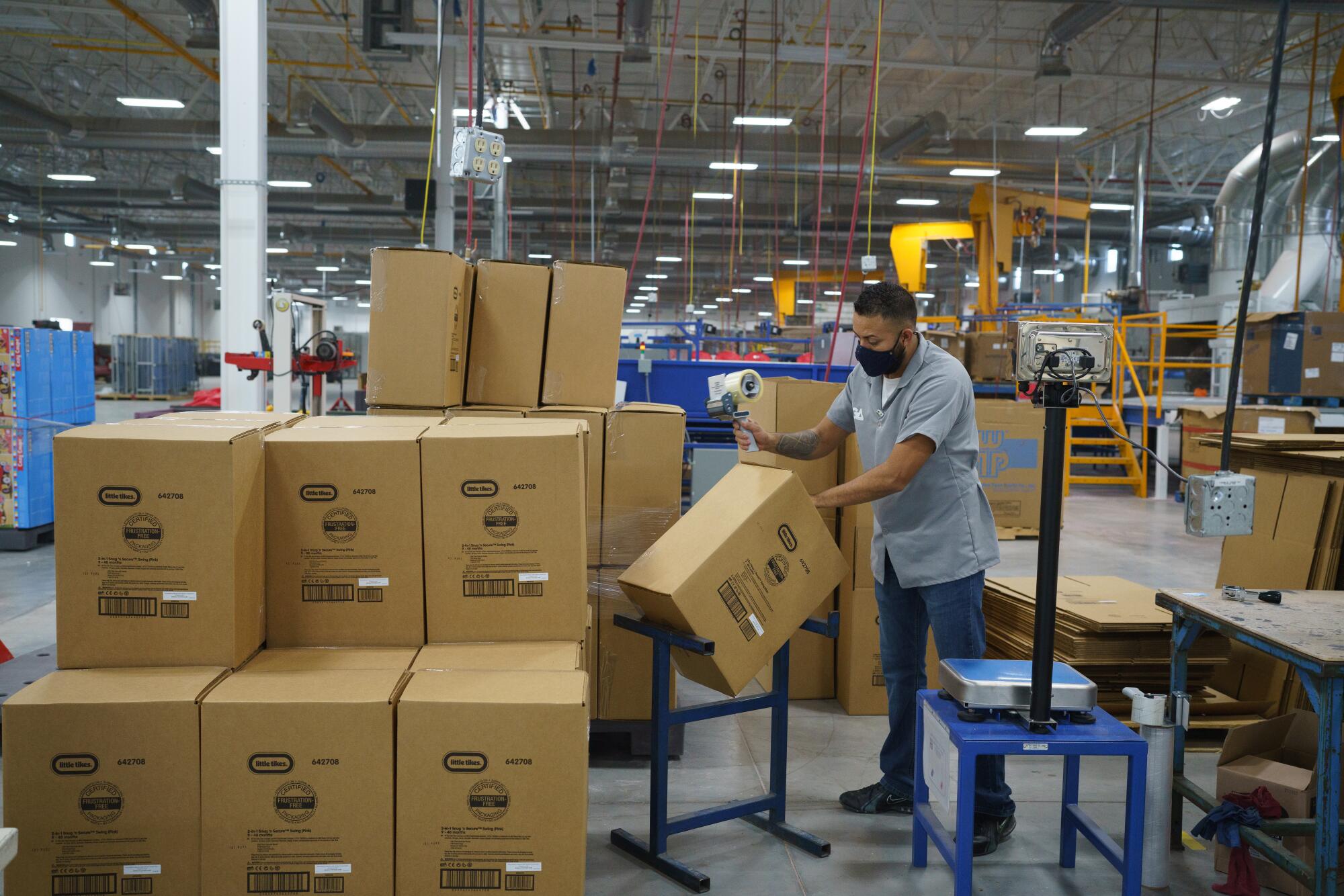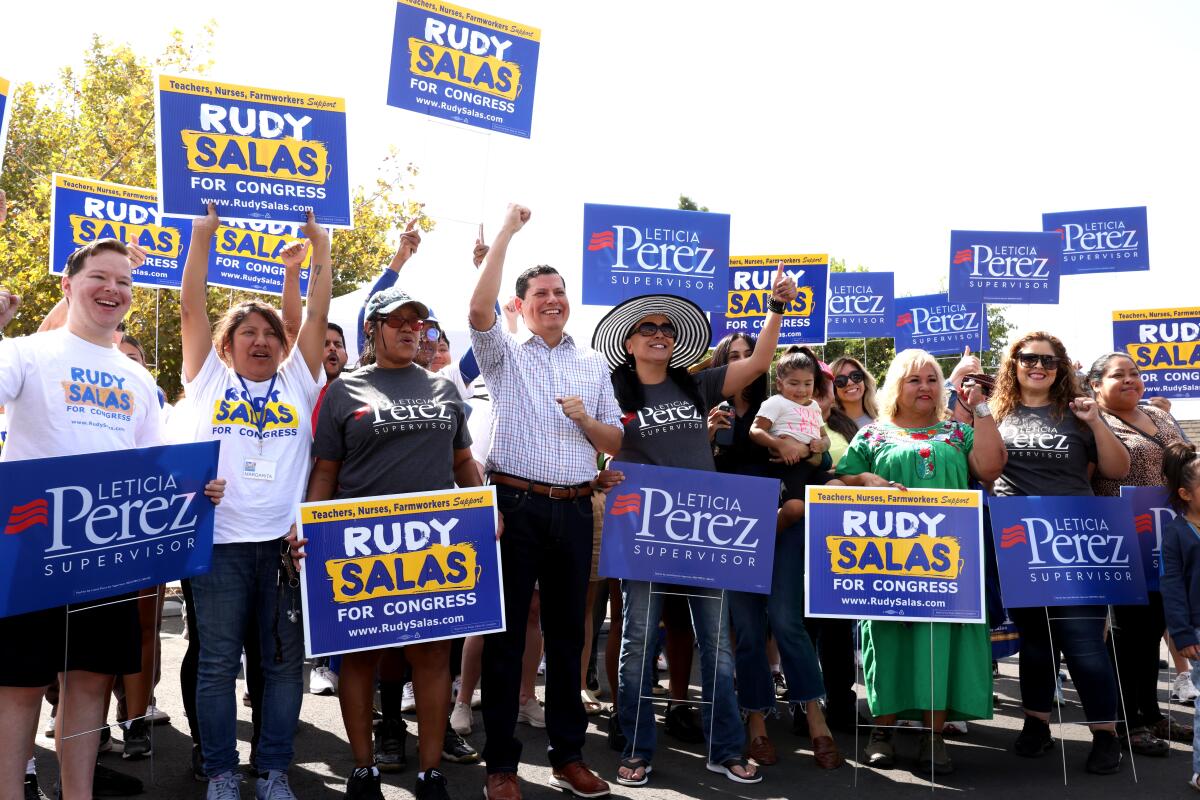MEXICO CITY —
If former President Trump is reelected and follows through with his promise to slap new tariffs on all imports to the U.S., experts say much of the global economy could be upended. And few countries would be more vulnerable than Mexico.
The economy here is driven almost exclusively by trade, with 83% of exports sent north of the border.
Mexicans are watching the U.S. election anxiously, and bracing for a possible Trump victory over the Democratic nominee, Vice President Kalama Harris. Last week, the peso lost value after polling showed that the former president had taken a slight lead in several swing states.
Economists warn that even a small increase in tariffs on Mexico’s goods could lead to a rise in unemployment and poverty, and some say that could prompt more people to migrate to the United States.
“Even the threat of tariffs will create havoc,” said Juan Carlos Moreno-Brid, an economics professor at the National Autonomous University of Mexico. “It will further reduce Mexico’s long-term economic growth. And it could drive migration to the United States and Canada.”

A worker packages Little Tikes baby swings at the MGA Entertainment factory in Ciudad Juarez, Mexico.
(Bloomberg / Getty Images)
Few world economies are more tightly bound than those of the U.S. and Mexico.
In 2023, U.S. exports of goods and services to Mexico totaled $367 billion and imports from Mexico exceeded $529 billion, according to the U.S. Department of Commerce. Mexico is the United States’ largest trading partner, having overtaken China in 2021.
Trump, who has long complained about the exodus of manufacturing jobs from the U.S. to countries such as China and Mexico, says that tariffs will help lure factories back to the United States.
Economists, though, are largely skeptical of that claim. And there’s some evidence that higher tariffs enacted during his presidency have cost American jobs. Many warn that U.S. companies would end up absorbing much of the new taxes, a cost they would pass on to U.S. consumers.
Some economists predict a 20% tariff imposed by Trump would end up costing the average U.S. family $2,600 each year. Harris says it could be higher, adding nearly $4,000 a year to the typical household’s bills, an increase she calls a “Trump sales tax.”
It’s difficult to say exactly what new tariffs would mean for the U.S. and the rest of the world because Trump’s proposals keep changing.
He has vowed, at various points, to impose an across-the-board tax of 10% or 20% on all goods entering the U.S. He’s also threatened tariffs of 60% or higher on imports from China.
In an interview this month with Fox News, he threatened to impose an exorbitant tax on autos imported from Mexico. A big chunk of U.S.-Mexico trade involves cars and auto parts that are transported back and forth across the border for production and final assembly.
“All I’m doing is saying, I’ll put 200[%] or 500%, I don’t care,” Trump said. “I’ll put a number where they can’t sell one car.”
New tariffs could trigger global trade wars because countries would probably retaliate with their own taxes on U.S. imports, targeting in particular farm goods because of the politically sensitive nature of that sector. The International Monetary Fund predicts growth would decelerate worldwide.

Donald Trump has vowed to impose a tariff of 10% or 20% on all goods entering the U.S. and threatened an exorbitant tax on autos imported from Mexico: “I’ll put 200[%] or 500%, I don’t care.”
(Rebecca Blackwell / Associated Press)
But countries such as Mexico, which relies heavily on exports for economic growth, would be especially affected.
The value of Mexico’s exports and imports amounts to almost 90% of the country’s gross domestic product, according to World Bank data. Economists warn that even a small increase in tariffs on goods destined to the U.S. poses serious risks for the economy.
“Under the worst-case scenario, the Mexican economy will fall into recession, the currency will depreciate, and inflation will rise,” reads a report released this month by the economic research firm Moody’s Analytics.
The mere threat of tariffs has already scared off foreign companies from investing in Mexico. Tesla, for example, announced that it was pausing plans to build a new factory in Mexico until after the election because of Trump’s vow to levy taxes against auto imports.
Trump appears willing to target individual companies doing business here, recently threatening 200% tariffs on John Deere if the tractor manufacturer moves production and jobs to Mexico.
“The threat of tariffs and the erratic nature in which Trump might deploy them doesn’t offer any investment certainty,” said Rodrigo Aguilera, an independent economist.
As president, Trump in 2018 imposed tariffs on steel from Mexico and other countries, prompting counter-tariffs on American farm goods and straining U.S.-Mexico relations.
He also threatened broader tariffs on all Mexican goods, but backed off after American business leaders complained that it would hurt them and his administration extracted a promise from Mexican authorities to do more to stop migrants from reaching the U.S. border.
Some Mexican officials have said they don’t believe Trump will follow through with his tariff threats, which aren’t popular in the U.S. and seen as counterproductive for the American economy.
Marcelo Ebrard, Mexico’s economy secretary, told journalists recently that he believes they are just a campaign tactic. “The United States economy is not a manufacturing economy,” Ebrard said. “And I’m sorry, but it will not be that way again.”
But others fear that Trump, if he wins a second presidency, will be more likely to take dramatic measures on an array of policies because it is likely he would be surrounded by more loyalists.
“Trump is not going to be moderated by more moderate conservatives,” said Pamela K. Starr, a professor of international relations at USC. “The second presidency, I think, will be Trump unleashed.”
Rodrigo Aguilera, an independent economist, said there is no doubt that Trump will “use a tariff threat to force Mexico to collaborate on something he wants, on migration policy or security policy.”
“Mexico,” he said, “will have to try to capitulate.”
If Trump enacts tariffs on Mexico, it would be in violation of the U.S.-Mexico-Canada Agreement, a 2020 treaty that replaced the Clinton-era North American Free Trade Agreement. The new treaty, which Trump helped negotiate, calls for generally no tariffs on trade on the North American continent. If the U.S. violated the agreement, Mexico would have permission to retaliate.
When they overlapped in office, Trump and former President Andrés Manuel López Obrador came to an unexpected detente. López Obrador said the two countries’ relationship was built on mutual respect, and famously called Trump “a friend.”
Many think such a relationship may be less likely with the country’s new president, Claudia Sheinbaum, and Trump, in part because he doesn’t have a good track record of working with female heads of state.
“She’s really smart and a woman, all things that Trump seems to find threatening,” Starr said.
Sheinbaum has largely refrained from commenting on Trump’s tariff threats, except to say that it is the U.S., as much as Mexico, that would suffer if they came to pass.
Free trade, she said recently, “is as important for the United States as it is for Mexico.”
Sheinbaum, who took office this month, inherited an economy that was already on shaky ground. The country faces its largest budget deficit since the 1980s. And while the social programs carried out by her predecessor helped lift some Mexicans from poverty, 36% of the population is still poor, with 7% living in extreme poverty.
Recent developments in domestic politics in Mexico have spooked some investors. Business groups have criticized an ongoing plan to overhaul Mexico’s justice system, which some say will undermine the independence of judges.
In Mexico and much of Latin America, poverty has a direct link to immigration. A severe recession in Mexico in the 1990s contributed to some 5 million Mexicans immigrating to the U.S.
Times staff writer Don Lee contributed to this report.


